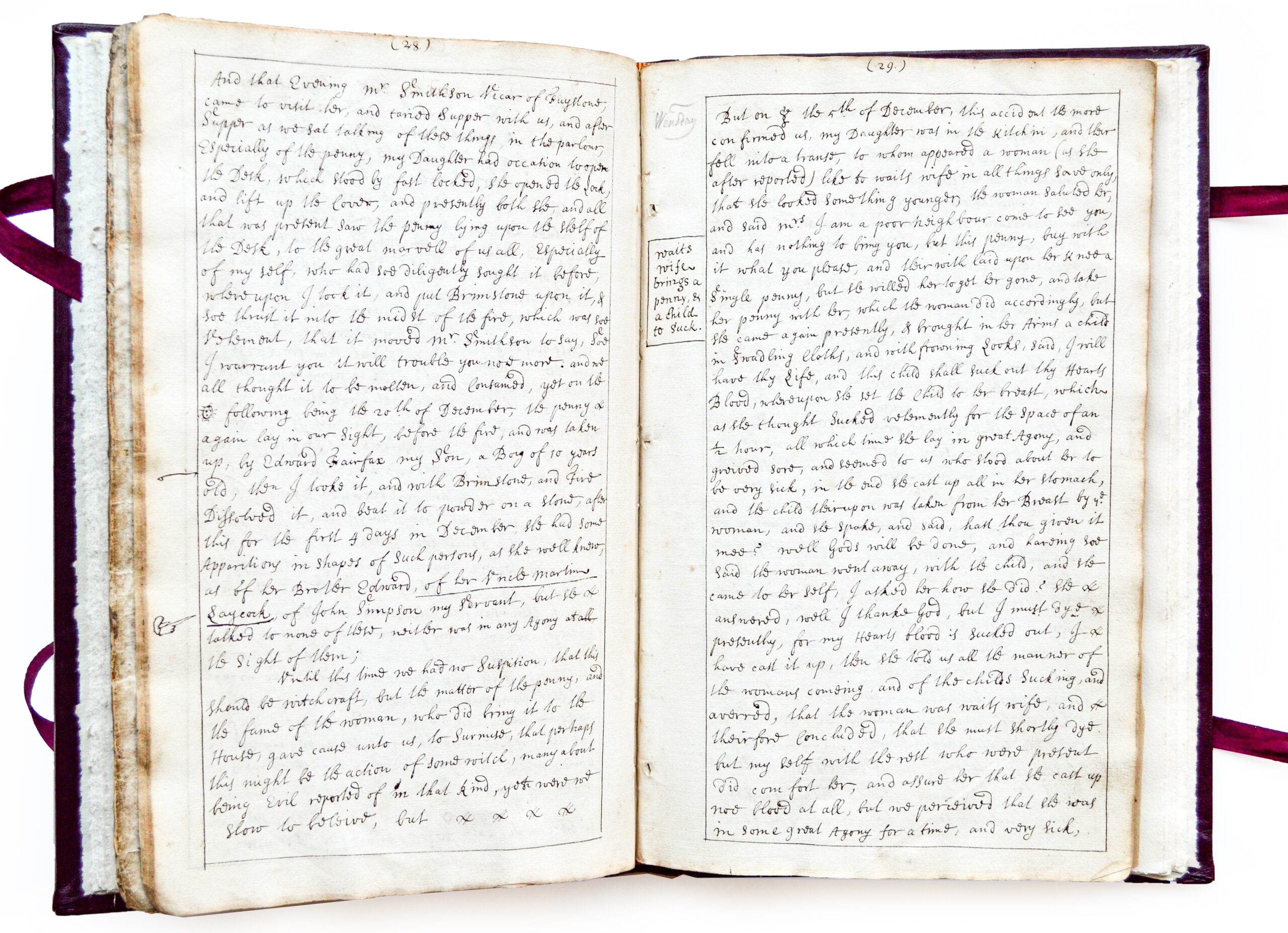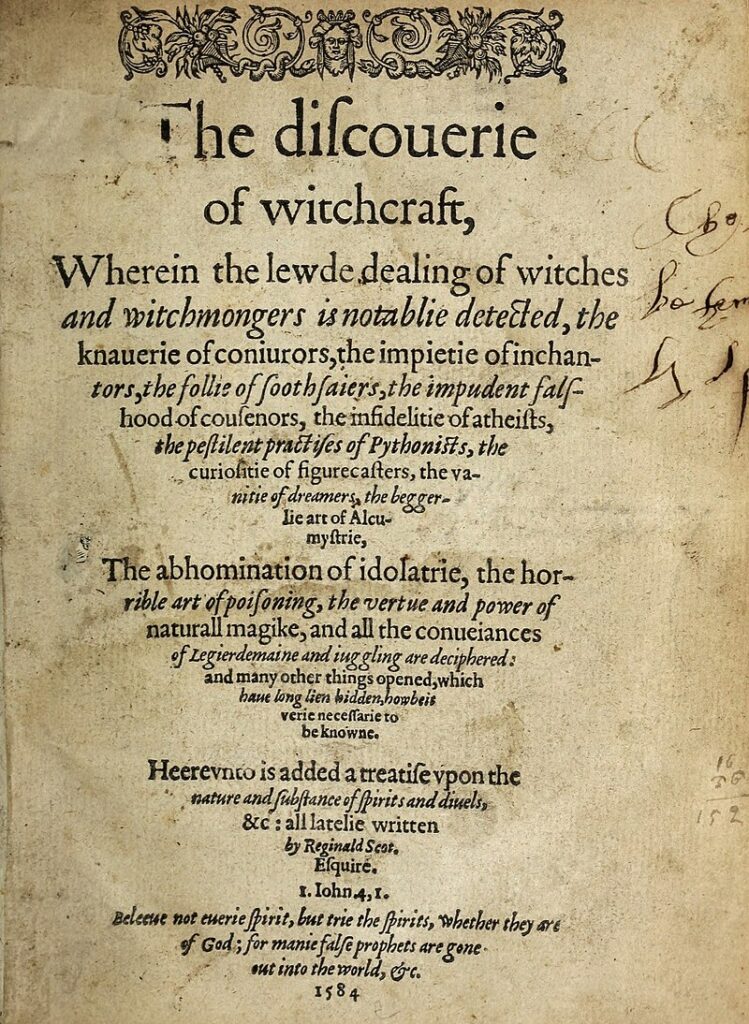
This article was published in The Wild Hunt by Manny Moreno.
YORK, England – Two of the most famous historical texts on witches and witchcraft were recently sold at a rare books auction in Yorkshire. The auction concluded on January 25, 2023, bringing top dollar for the lot of books because of “the quality and rarity of the volumes in the library” and the exceptional state of conservation of the texts by the collector.
The library of David Stather was placed on auction by Tennants Auctioneers late last year following his death. Stather was a lawyer practicing in York, U.K., and an avid collector of antiquarian books since his youth with specific interests in history and law. After retiring from his legal practice, he devoted himself to researching local history and growing his antiquarian book collection. His retirement afforded him the chance to rescue “many worthy books in a forlorn state and had them bound in befitting style, taking great pleasure in ensuring their continued survival for centuries to come,” according to Fine Books Magazine.
Most of the texts in the Stather Library involved books and ephemera from the English Civil War (1642–1651). Among the various pieces of the library’s collection were Civil War Pamphlets and letters from key figures in the war about the battles.
The collection also includes material from the Popish Plot, a fictitious conspiracy that promoted social division via in anti-Catholic hysteria – an early example of fake news.

The collection also included a copy of the Great Bible printed by Edwarde Whitchurche in London in 1549, a 1573 copy of the foundational texts of the Church of England by William Tyndale, John Frith, and Dr. Barnes, and a manuscript signed by Edward Winslow, a leader of the Pilgrim Fathers who sailed on the Mayflower to Massachusetts in 1620. Other bibles and prayer books were in the collection.
The collection also included two famous texts on witchcraft: the Malleus Maleficarum and The Discoverie of Witchcraft, the latter in both a 1584 first edition and a 1665 third edition.
The Malleus Maleficarum is one of the most well-known books related to witchcraft, and certainly well-known to most modern Witches and Pagans. The 15th century treatise concerns how to identify the power of witches and conduct witch trials.
Commonly translated as “The Hammer of Witches,” the treatise was written by German Catholic clergyman Henricus Institor (Heinrich Kramer) in the city of Speyer in 1486, following his expulsion from Innsbruck by a local bishop. Jacob Sprenger was added as an author beginning in 1519, about 33 years after the Malleus Maleficarum‘s first publication and 24 years after his death.

The Malleus Maleficiarum essentially elevated sorcery to heresy and advised acts of torture and death to gain confessions from believed practitioners of witchcraft, three quarters of whom were women. The text begins with “proof” that witchcraft exists and then describes the powers and activities of witches. It is widely regarded as a text of patriarchal oppression, misogyny, and brutality. Even top theologians of the Inquisition would condemn the Malleus as unethical. The book was declared “false” by the Catholic Church in 1489 but its reference and use persisted well into the 17th century.
The Discoverie of Witchcraft was a skeptical text written by Reginald Scot, an Englishman and member of Parliament, as a exposé on witchcraft. The book is formally titled The Discoverie of Witchcraft, wherein the Lewde dealing of Witches and Witchmongers is notablie detected, in sixteen books … whereunto is added a Treatise upon the Nature and Substance of Spirits and Devils.”
Scot believed that witchcraft was irrational and the text describes how the public can be fooled by charlatans. Scot held the Roman Church responsible for the dissemination of the irrational belief in witchcraft, and popular belief held that all copies of Discoverie were destroyed in the reign of James I, the son of Mary, Queen of Scots, who through his ascension to the English throne united England and Scotland.
It is unclear how Mr. Stather acquired these copies of Malleus Maleficarum or The Discoverie of Witchcraft. But the English Civil War may hold a clue. The war between Royalists and Parliamentarians concerned not only England’s governance but also issues of religious freedom. The Winslow letter, for example, dates to after the end of the English Civil War, when he joined a committee that allowed Royalists to regain their confiscated fortunes in exchange for their pledge to not take up arms against Parliament. So the presence of these texts as both legal and historical material from the period were not seen as unusual.
The Stather Library collectively sold for £272,570, significantly exceeding the pre-sale estimates for the collection. Each edition of The Discoverie of Witchcraft, valued at between £3,000 to £5,000, sold for £6,000, while the Malleus Maleficarum, estimated at £500 to £800, sold for £5,500.
You can visit The David Stather Library Auction full listings HERE
You can check out the direct link to this article on the The Wild Hunt – Pagan News & Perspectives here:
https://wildhunt.org/2023/01/famous-witchcraft-texts-sell-for-a-tidy-sum.html
